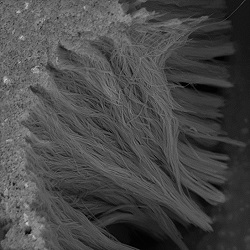Some of the most remarkable material properties occur in biological materials. Bone, for example, is a phenomenal composite material with an outstanding combination of stiffness, strength and toughness. Furthermore, bone is able to heal itself and is produced from inherently environmentally substances. Taking inspiration from the biological world is perhaps not a bad place to start if we are to produce a new generation of materials for use in engineering, medicine and devices.
These biological materials grow at a cellular level. Cells are the building blocks of all life on Earth and collectively can form highly complex systems. If we are to exploit the properties of natural materials and tailor them to our needs, it is necessary to control the behaviour of the cellular systems.
Unfortunately, interfacing directly with cells to dictate their behaviour is far from simple. The chemical pathways and mechanisms that typically regulate cell function have been devised over millions of years of evolution, resulting in fiercely complex and finely balanced systems. Interfering with these schemes rarely succeeds.
However, a new and emerging field of research known as mechanobiology may offer a solution to this problem. This describes the phenomenon that cellular systems are exceptionally sensitive to their mechanical environment. That is, the function and behaviour of cells can be regulated by the physical properties of their surroundings and the forces that they experience. As an example, human stem cells grown on a soft substrate are likely to differentiate into fat cells, while growing those same stem cells on a rigid substrate will lead to the formation of bone cells.
The challenge of controlling cell function is then shifted to the challenge of controlling the mechanical properties of cell surroundings. This is the principal focus of my PhD research; to develop a tool which can interface directly with cellular systems through mechanical stimuli.
Piezoelectric materials are an interesting set of materials which may make this possible. Piezoelectric materials can generate electric charge when they are deformed. This property has resulted in their use in many applications, from keeping time inside your computer to the spark-generating element in held-held gas lighters. What’s more, the effect can be reversed; applying electric charge will cause the material to deform. This means that the same material can be used to both detect and apply forces.
By combining this piezoelectric material with a grid of electrodes, just like that found on your phone’s touch screen, a ‘touch screen for cells’ can be created. The electro-mechanical interaction that occurs between the growing cells and the piezoelectric material could be detected by this grid of electrodes, enabling a good degree of spatial resolution for the measurements. Furthermore, this grid of electrodes can be used to apply signals to the piezoelectric material, thus applying forces to the growing cells. This moves closer towards the idea of controlling cell function through mechanical stimulation.
There are many challenges in producing such a device, one of which is creating a piezoelectric material that is sensitive enough to detect the small forces that occur between cells. It is here that the realm of ‘nanotechnology’ becomes useful. By making extremely thin ‘nanowires’ of piezoelectric material, the sensitivity of the structure to deformation can be greatly increased. The nanowires shown in the image are 200 nm in diameter, roughly 500 times smaller than a single human hair.
The investigations are still very much a work in progress, but it is hoped that the outcomes will enable a new and exciting method of interfacing with biological systems, and potentially controlling their behaviour.
Michael Smith
NanoDTC PhD Associate 2015
Department of Materials Science

